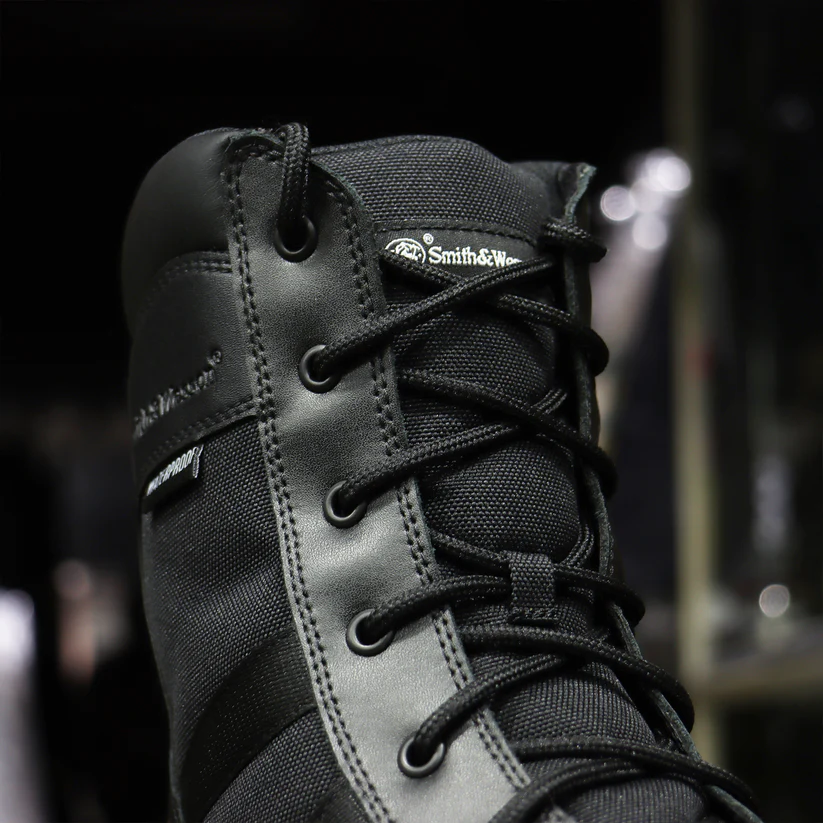I’m well acquainted with the Smith & Wesson brand, but mostly so with their more popular and older products. What I’m about to describe was pretty much a discovery for me: the legendary brand branched out and started to produce footwear! For some people, this will be no news since the Breach 2.0. series launched sometime in 2016, which was no less than 8 years ago. Well, at least the boots had enough time to be tested inside and out, and today I’ll join the ranks of Smith & Wesson Footwear testers. If you are curious about how good a firearm brand is at making boots, bear with me, I’ll start in just a second.
A single glance is enough to put a “tactical” tag on the pair of Breach 2.0 boots. It’s pretty apparent what Smith & Wesson was aiming for, so I should mention they managed to stay true to the “idea” of their brand. But tactical boots have quite a number of myths and expectations surrounding them, and it’s hard not to put labels on things that look like other things. As such, I’ll review these boots according to the standards of tactical footwear. You’ll see that in some respects, Smith & Wesson outdid themselves whereas some of them could be improved.
Table of Contents
Comfort
Protection
Quality
Grip
Breathability
Longevity
Other Features
Pros and Cons
FAQs
Comfort: In Rest and On the Go
Starting with size and weight, these boots look quite large, in the best traditions of tactical footwear. However, their bulk miraculously does not translate into weight. That was actually the first thing that pleasantly surprised me. You usually expect tactical boots to be bulky, but Breach 2.0 boots are anything but bulky. They felt really light on my feet but still had the look of rigidity to them. If you need substantial footwear that won’t weigh you down, Smith & Wesson Breach 2.0 boots are great candidates.
I put them on, admiring how lightweight they felt, and then I started walking. Nothing happened, at least nothing that could change my mind: walking in these boots felt awesome. I prefer not to tighten up my boots too much, especially tactical ones, given how rigid they usually are, and nothing brought any discomfort.
After walking for a while, I decided to lace them tighter and got what I deserved: the collar started to rub against my lower leg. That marked the end of my experiment and I reset the boots to their standard settings. I kept them on for a day and was pleased with the results. Whether I was walking, standing or sitting, they offered excellent comfort.
I’ve also read a great deal of reviews on Amazon and most of them seem to echo my experience. They were even praised by police officers and security guards who wore them for more extended periods, so there is nothing these boots can’t handle, outdoors or city.
Or is there? Since it’s tactical boots we’re talking about, I felt like I really needed to test them by running. Right from the start, the rigidity of the boot made sprinting a bit challenging. Not impossible, of course, but not a cakewalk either. Some will say that the boots weren’t broken in and they will be right: they weren’t. But I wasn’t sure whether that was the only reason. The front part and the toe box didn’t have much flexibility, and I didn’t know at the time whether that would change.
It did, though, not completely but significantly. It took me the whole week of not wearing any other boots, but I managed to break them in. And so running became much easier, which I was happy about.
The last standout feature that I’d like to talk about in terms of comfort is the side zip. It’s ridiculous how good that feature is. It makes a world of difference in terms of convenience and makes putting on and taking off these boots a breeze. I didn’t even need to touch my laces once, which is quite fine by me.

SMITH & WESSON FOOTWEAR Men's Breach 2.0 8in Side Zip Boots
$63.99
Price accurate at time of writing
Specs:
- Leather/nylon upper for added protection and comfort
- YKK side zipper in durable Vislon pattern for easy on and off fit with hook and loop tab-stay closure
- PU Collar for easy cleaning
- Foam-padded collar and tongue for protection and increased breathability
- Gusseted tongue to keep dirt and debris out
- EVA Midsole for lightweight comfort and cradled support
- Steel shank for superior support
- Board-lasted construction for torsional rigidity, reducing foot fatigue during long work shifts
- Slip-resistant, non-marking rubber outsole
Protection From the Elements
Tactical boots are supposed to face all the challenges of the outdoors with valor and overcome them with ease. At least that’s what people expect. However, the presence of the side zip and the general appearance of these boots will tell you right away: they aren’t waterproof. But they are not advertised as waterproof, so there is nothing wrong with that.
That doesn’t mean they won’t protect your feet, though. First, the shaft stands at 8 inches. I ran through dewy grass once and managed to keep my feet dry. Walking through tall grass or underbrush wasn’t an issue either, nothing managed to get past them. Whereas I don’t expect them to perform equally well when submerged in water, they proved to be pretty water-resistant.
Among the reviews, there was a story of a customer who complained about the sand. He said that sand could bypass the laces and the tongue when he used a backpack blower to clear trails. While not a common scenario, it’s worth considering if you happen to be in sandy environments.
Also, these aren’t work boots: you won’t find a steel toe here. While this might bring down the protection capabilities, it contributes significantly to the boot’s lightness.
P.S. If you are looking for a waterproof version of these boots (like on the photo above), Smith & Wesson released Breach 2.0. Waterproof. I didn’t test them personally, but since Waterproof is literally in the title and Smith & Wesson proved to be great shoemakers so far, there is no reason not to believe them.

SMITH & WESSON FOOTWEAR Men's Breach 2.0 Waterproof 8in Side Zip Boots
$71.99
Price accurate at time of writing
Specs:
- HydroGuard waterproof construction
- Leather/nylon upper for added protection and comfort
- YKK side zipper in durable Vislon pattern for easy on and off fit with hook and loop tab-stay closure
- PU Collar for easy cleaning
- Foam-padded collar and tongue for protection and increased breathability
- Gusseted tongue to keep dirt and debris out
- EVA Midsole for lightweight comfort and cradled support
- Steel shank for superior support
- Board-lasted construction for torsional rigidity, reducing foot fatigue during long work shifts
- Slip-resistant, non-marking rubber outsole
Quality Control
The quality of these boots is generally excellent: the seams seem to be of good quality, no part of the boot looks wobbly, the eyelets are even, the laces are sturdy – everything looks decent. I will only warn you to be careful with the toe area. I tried the Black model, and it seems to utilize the material that is easily scratchable if you are not careful. And since the outdoors doesn’t leave you too many options, the boots will most likely look scuffed up after a while. However, this doesn’t impact their performance; it’s purely an aesthetic concern.
Slip Resistance
Tactical footwear isn’t meant for paved roads, even though it performs excellently when tested on them. We are more interested in difficult terrain, something slippery and impassable, that strives to make you lose your footing. The aggressive outsole of Smith & Wesson Breach 2.0 provides excellent grip and slip resistance. Wet grass didn’t beat it, mud didn’t either, let alone regular surfaces, even wet ones. This makes me pretty confident they’ll make for great hunting boots.
Temperature Control
How cold or warm you’ll feel in these boots depends heavily on how active you are. They do have ventilation pores that allow for air circulation, so they are breathable. However, during strenuous activities like prolonged running, it became hot quickly. When I was less active (the majority of the time) these boots struck a perfect balance between keeping my feet cool and warm. I think that issue can be addressed by getting dedicated boot socks. Like Wartorn Merino Boot Socks from Viktos, with temperature-regulating chassis.
Longevity
I should have started wearing these boots a year or two ago to provide an adequate assessment of their longevity, but I have only been wearing them for a week. The best I can say from personal experience is that the finish on the toe area will probably be the first to wear off. Again, this has more to do with appearances rather than functionality, but it is longevity nonetheless. No other aspect gives any reason to doubt the ability of the boots to pass the test of time.
Other Noteworthy Features
One of the trickiest things with footwear is sizing. Sometimes it seems like everyone has standards of their own. But it’s not the case with Smith & Wesson boots. I usually take 10.5, so I decided to try my luck and took 10.5 here as well. I hit the bullseye: there is still enough room in the toe box and the rest of the boot fits snugly.
One important note from one of the reviewers: AVOID drying them near a fire. The midsole may start melting if the heat is too intense, which would definitely compromise the boot’s integrity. I didn’t try to fire-dry them myself, and with that information, I don’t think I ever will.
Conclusion
What’s my verdict for Smith & Wesson Breach 2.0 boots after wearing them for a week? They are GREAT. I say this acknowledging the fact that the boots need to break in for you to experience their true potential and you need to buy socks specifically for these boots. But honestly, for the money they cost, it’s nothing short of an asset. It’s not often that you can get a pair of good tactical boots for less than a hundred bucks. They are super lightweight, they are sturdy, and they feel breathable. The side zip is the cherry on top. I only wish the toe box wasn’t so prone to scratching, but function goes before appearances with tactical boots.
FAQs
Are the Smith & Wesson Breach 2.0 boots waterproof?
That depends majorly on the model. The regular Breach 2.0 boots are water-resistant and can easily withstand walking through dewy grass and tall grass or underbrush. There is also the Waterproof model that features HydroGuard waterproof construction.
Do the Smith & Wesson Breach 2.0 boots have a steel toe?
No, these boots do not have a steel toe. They are not work boots and prioritize lightness over steel toe protection.
Are Smith & Wesson Breach 2.0 boots high quality?
The quality of these boots is generally excellent. The seams, eyelets, and laces are sturdy, and the boots look really well-made. The toe area is prone to scratching, but that is purely an aesthetic concern.
Are the Smith & Wesson Breach 2.0 boots slip-resistant?
Yes, the boots have an aggressive outsole that provides excellent grip and slip resistance.
How is the breathability of the Smith & Wesson Breach 2.0 boots?
The boots have ventilation pores for air circulation, which makes them breathable. During less active periods, they strike a balance between keeping feet cool and warm. However, during activities like running, they can become hot quickly.
What is the sizing like for the Smith & Wesson Breach 2.0 boots?
The boots appear to have consistent sizing. There is no need to go half a size or down.
















